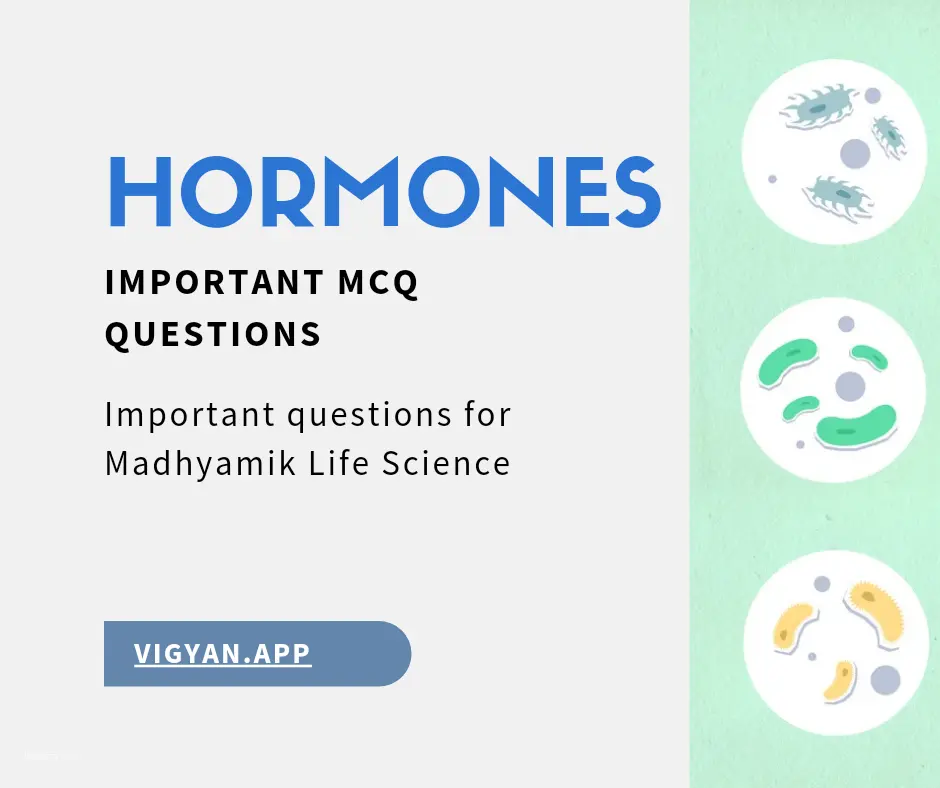
Important Questions for Madhyamik Pariksha Life science Adaptation (अनुकूलन )
Important Questions for Madhyamik Pariksha Life science Adaptation बहुविकल्पिक प्रश्न (MCQ type questions)
दिए गए विकल्पों में से सही उत्तर को चिह्नित करें। (Tick the correct answer from the given options.)
MCQ for Madhyamik Pariksha
- फाइलोक्लेड किसमे पाया जाता है। (Phylloclade Is found In)
(a) कैक्टस (Cactus)
(b) कमल (Lotus)
(c) सुन्दरी (Sundari)
(d) मटर का पौधा (Pea plant)
Ans. (a) कैक्टस (Cactus) में
- निम्नलिखित में कौन अस्थि-युक्त मछलियों में स्विमब्लैडर की गैस अवशोषित करता है-
(Which of the following absorbs the gas of swim bladder in bony fishes)
(a) लाल ग्रन्थि (Red gland)
(b) अग्र प्राकोस्ठ (Anterior chamber)
(c) गैस्ट्रिक ग्रन्थि (Gastric gland)
(d) रेटी मिराविलिआ (Retia mirabilia)
Ans. (a) लालग्रन्थि (Red gland)
- रोहू मछली वाताशय की सहायता से क्या कर सकती है – (With the help of swimbladder, rohu fish can) –
(a) जल में उत्प्लावन (float in water)
(b) जल में तैरना (swim in water)
(c) जल की किसी भी गहराई में स्थिर होना (be stable at any depth of water)
(d) उपरोक्त सभी कार्य (perform all these functions)
Ans. (d) उपरोक्त सभी कार्य (perform all these functions) कर सकती है।
- हैलोफिटिक पौधा ‘सुन्दरी’ का कौन-सा अंग उसे वायुमण्डलीय ऑक्सीजन को लेने में सहायता करता है?
(a) जटामूल
(b) न्यूमेटोफोर्स
(c) हैपटेरा
(d) पत्तियाँ
Ans. (b) न्यूमेटोफोर्स अंग
- कबूतर में वायु प्रकोष्ठों की संख्या कितनी है – (Number of air sac in pigeon is -)
(a) 7
(b) 8
(c)10
(d) 9
Ans. (c) 9
- किसमे न्यूमैटोफोर्स देखे जाते हैं – (Pneumatophore is present in -)
(a) सुन्दरी (Sundari)
(b) नारियल (Coconut)
(c) कैक्टस (Cactus)
(d) कमल (Lotus.)
Ans. (a) सुन्दरी (Sundari)
- निम्नलिखित से हाइड्रोफाइट की जड़ में क्या होता है (which of the following is found in root of Hydrophytes):
(a) मूल टोप होता है। (Root cap is present)
(b) मूल टोप नहीं होता है। (Root cap is absent)
(c) वायुकोष (Air sac)
(d) वाह्यचर्म (Epidermis)
Ans. (b) मूल टोप नहीं होता है।(Root cap is absent)
- कमल की तैरती पत्तियाँ कैसी होती हैं। (Floating leaves of lotus are):
(a) लम्बी (Long)
(b) चौड़ी (Broad)
(c) छोटी (Short)
(d) बड़ी थाली नुमा (Large disc like)
Ans. (d) बड़ी थाली नुमा (Large disc like)
- पक्षी की हड्डियाँ कैसी होती हैं। (Bones of birds are):
(a) खोखली (Hollow)
(b) ठोस (Solid)
(c) अर्द्ध ठोस (Semi solid)
(d) इनमें कोई नहीं। (None of the above)
Ans. (a) खोखली (Hollow) होती हैं। - पंख किसके रूपान्तरित रूप है। (WIng is modification of):
(a) अगले पैर का (Fore limb)
(b) पिछले पैर का (Hind limb)
(c) पसलियों का (Ribs)
(d) इनमें कोई नहीं (None of above)
Ans. (a) अगले पैर का (Fore limb)
Suggestions for Madhyamik Life Science from Adaptation ( अनुकूलन )
Important Questions for Madhyamik Pariksha Life science in Hindi
- मछली में पखनों की संख्या कितनी है। (The number of fins in fishes are):
(a) 5
(b) 6
(c) 7
(d) 8
Ans. (c) मछली में पखनों की संख्या 7 है। - मायोटोम पेशी किसमे पायी जाती है। (Myotome muscle Is found in):
(a) मनुष्य में (Man)
(b) मछली में (Fish)
(c) पक्षी में (Bird)
(d) किसी में नहीं (None of these)
Ans. (b) मछली में (Fish) - सहायक श्वसन अंग किसमे पाया जाता है। (Accessory respiratory organs are found in):
(a) रोहू में (In Rohu)
(b) कतला में (In Catla)
(c) कवई में (In Koi)
(d) हिल्सा में (In Hilsha)
Ans. (c) कवई में (In Koi) - जल संचय उत्तक किसमे पाया जाता है। (Water storing tissues are found):
(a) हाइड्रोफाइट में (In hydrophytes)
(b) जीरोफाइट में (In xerophytes)
(c) हैलोफाइट में (In halophytes)
(d) मिजोफाइट में (In mesophyte)
Ans. (b) जीरोफाइट में (In xerophytes) - निम्नलिखित में किसमे स्टोमैटा बहुत कम होता है। (Stomata Is scarce In):
(a) हाइड्रोफाइट में (Hydrophyte)
(b) जीरोफाइट में (Xerophyte)
(c) दोनों में (In both)
(d) मिजोफाइट में (In mesophyte)
Ans. (b) जीरोफाइट में (Xerophytes) - किसमे हड्डियाँ छिद्रदार तथा कम वजन की होती हैं। (Bones are Porous and light weight in):
(a) पक्षी में (In birds)
(b) स्तनधारी में (In mammals)
(c) मछली में (In fish)
(d) उपरोक्त सब में (In all of the above)
Ans. (a) पक्षी में (In birds) - किस पौधा में पर्णकंटक होते हैं – (The plant in which leaf spines are present is -)
(a) कैक्टस (Cactus)
(b) खजूर (Date palm)
(c) उड ऐप्पल (wood apple)
(d) गुलाब (Rose)
Ans. (b) खजूर (Date palm) - बैगल डाँस विशेषता है – (The characterestic of waggle dance -)
(a) मधुमक्खी (Honey bee)
(b) मक्खी (House fly)
(c) मच्छर (Mosquito)
(d) arişi (Insect)
Ans. (b) मधुमक्खी (Honey bee) - मैंग्रोव पौधा का एक उदाहरण है – (which is an example of mangrove plant)-
(a) कैक्टस (Cactus)
(b) सुन्दरी (Sundari)
(c) कमल (Lotus)
(d) मटर (Pea)
Ans. (b) (Sundari) - निम्नलिखित में से किस जंतु में खोखली अस्थियां पायी जाती हैं? (The bones of which of the following is pneumatic-)
(a) कबूतर ( pigeon)
(b) साँप ( snake)
(c) मछली ( Fish)
(d) मनुष्य ( Man)
Ans. (a) कबूतर ( pigeon)
Important Questions for Madhyamik Pariksha Life science with Answers
You May Also Like
Important Questions from Life Science-2 (जीव विज्ञान के कुछ महत्वपूर्ण प्रश्न)
- जैव विविधता (Biodiversity): महत्व, प्रकार, संरक्षण और भारत में स्थिति
- Artificial Intelligence to Be Taught in Indian Schools from Class 3 Starting 2026
- Zoho Arattai App with Zia AI and Enhanced Privacy Features Challenges WhatsApp
- Zoho Arattai The 20 Year Tech Journey Behind India’s Swadeshi Messaging App
- Nobel Prize Winners 2025: नोबेल पुरस्कार 2025 की पूरी जानकारी हिंदी में
अनुरोध:- अगर आपको Important Questions for Madhyamik Pariksha Life science अच्छा लगा हो तो अपने दोस्तों को भी इसके बारे में बतायें ताकि वो भी इसका फायदा ले सकें । इस में अगर कोई गलती हो तो कमेंट करके जरुर बतायें, इसको सुधारने के बारे में आपका कोई भी सुझाव हो तो जरुर बतायें ताकि हम इसको और बेहतर कर सकें । धन्यवाद !
VIGYAN अब टेलीग्राम पर भी उपलब्ध है, नियमित अपडेट के लिए हमारे टेलीग्राम चैनल से जुड़ें – https://t.me/vigyanofficial


